英语语言学基础知识
语言学知识点
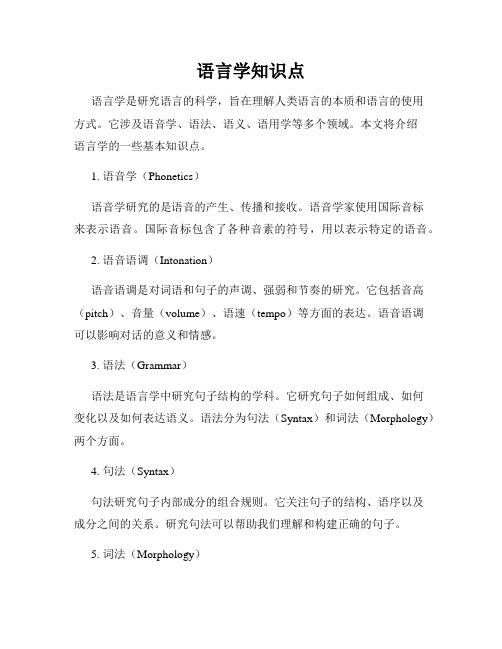
语言学知识点语言学是研究语言的科学,旨在理解人类语言的本质和语言的使用方式。
它涉及语音学、语法、语义、语用学等多个领域。
本文将介绍语言学的一些基本知识点。
1. 语音学(Phonetics)语音学研究的是语音的产生、传播和接收。
语音学家使用国际音标来表示语音。
国际音标包含了各种音素的符号,用以表示特定的语音。
2. 语音语调(Intonation)语音语调是对词语和句子的声调、强弱和节奏的研究。
它包括音高(pitch)、音量(volume)、语速(tempo)等方面的表达。
语音语调可以影响对话的意义和情感。
3. 语法(Grammar)语法是语言学中研究句子结构的学科。
它研究句子如何组成、如何变化以及如何表达语义。
语法分为句法(Syntax)和词法(Morphology)两个方面。
4. 句法(Syntax)句法研究句子内部成分的组合规则。
它关注句子的结构、语序以及成分之间的关系。
研究句法可以帮助我们理解和构建正确的句子。
5. 词法(Morphology)词法研究词的内部结构和变化规律。
它关注单词的构成要素(词根、词缀等)以及单词形态的变化。
6. 语义学(Semantics)语义学是研究词义和句义的学科。
它关注语言符号与现实世界之间的关系,研究词语和句子的意义。
语义学可以帮助我们理解语言的意义和表达的方式。
7. 语用学(Pragmatics)语用学研究语言在具体语境中的使用和解释。
它关注的是说话人的意图、听者的理解以及背后的非字面意义。
语用学帮助我们理解语言的社交功能和交际规则。
8. 语言变体(Language Variation)语言变体指的是同一语言在不同社会群体之间产生的差异。
这些差异可以体现在发音、词汇、语法以及语用等方面。
语言变体是语言学中一个重要的研究领域。
9. 二语习得(Second Language Acquisition)二语习得研究的是学习第二语言的过程和条件。
它包括语言输入、语言输出和语言环境对第二语言学习的影响等方面。
英语语言学知识点总结

英语语言学知识点总结
英语语言学是研究英语语言及其发展历史、语音、语法、词汇、语用等方面的学科。
以下是一些英语语言学的知识点总结:
1. 英语语音学:英语语音学主要研究英语的发音、声调、重音等语音现象。
其中,英语的发音规则主要包括元音、辅音和声调等方面的规则。
2. 英语语法学:英语语法学主要研究英语的语法结构和规则,包括句子结构、时态、语态、名词、形容词、副词等语法范畴。
3. 英语词汇学:英语词汇学主要研究英语的词汇构成、演化和使用情况,包括单词、词组和习语等方面的研究。
4. 英语语用学:英语语用学主要研究英语的语用功能和语境,包括语言交际、暗示、礼貌、语用失误等方面的研究。
5. 英语语音语调学:英语语音语调学主要研究英语的语音语调系统,包括英语的发音、声调、重音、节奏等方面的研究。
6. 英语文体学:英语文体学主要研究英语的文体风格和语言习惯,包括正式文体、口语文体、文学文体等方面的研究。
7. 英语词汇记忆学:英语词汇记忆学主要研究如何有效地记忆英语词汇,包括词汇记忆的方法、技巧和策略等方面的研究。
8. 英语跨文化交际学:英语跨文化交际学主要研究英语在不同文化中的交际和使用,包括跨文化沟通、文化差异、交际礼仪等方面的研究。
以上是一些英语语言学的重要知识点总结,不同学科之间的交叉
和融合也在不断推进着英语语言学的发展。
英语语言学知识点

英语语言学知识点英语语言学是英语语言文学专业培养计划中的一门基础必修课,接下来店铺为你整理了英语语言学知识点,一起来看看吧。
英语语言学知识点:定义1.语言学LinguisticsLinguistics is generally defined as the scientific study of language.2.普通语言学General LinguisticsThe study of language as a whole is often called General linguistics.3.语言languageLanguage is a system of arbitrary vocal symbols used for human communication.语言是人类用来交际的任意性的有声符号体系。
4.识别特征Design FeaturesIt refers to the defining poperties of human language that distinguish it from any animal system of communication.语言识别特征是指人类语言区别与其他任何动物的交际体系的限定性特征。
Arbitrariness任意性Productivity多产性Duality双重性Displacement移位性Cultural transmission文化传递⑴arbitrarinessThere is no logical connection between meanings and sounds.P.S the arbitrary nature of language is a sign of sophistication and it makes it possible for language to have an unlimited sourceof expressions⑵ProductivityAnimals are quite limited in the messages they are able to send.⑶DualityLanguage is a system, which consists of two sets of structures ,or two levels.⑷DisplacementLanguage can be used to refer to contexts removed from the immediate situations of the speaker.⑸Cultural transmissionHuman capacity for language has a genetic basis, but we have to be taught and learned the details of any language system. this showed that language is culturally transmitted. not by instinct. animals are born with the capacity to produce the set of calls peculiar to their species.5.语言能力CompetenceCo mpetence is the ideal user’s knowledge of the rules of his language.6.语言运用performancePerformance is the actual realization of this knowledge in linguistic communication.语言运用是所掌握的规则在语言交际中的体现。
(827)英语语言学知识

英语语言学是研究英语语言的科学领域,它涵盖了英语的语音、语法、词汇、句法、语义以及语用等方面的研究。
本文将从不同角度介绍英语语言学的基本概念、研究方法以及一些相关的重要理论。
一、语音学语音学是研究语音的科学,它关注的是语音的产生、传播和感知。
在英语语言学中,我们需要了解英语的音素和音系,即英语中的音位和音位之间的关系。
此外,我们还需要了解如何正确地发音,包括英语的元音和辅音。
二、语法学语法学是研究语言的结构和规则的科学,它关注的是语言中单词和句子的组成以及它们之间的关系。
在英语语言学中,我们需要了解英语的基本句型和句子成分的分类。
同时,我们还需要学习英语的时态、语态和语气等语法现象。
三、词汇学词汇学是研究词汇的科学,它关注的是词汇在语言中的作用和使用。
在英语语言学中,我们需要了解英语的词汇分类和词义的多样性。
同时,我们还需要学习如何正确地使用英语词汇,包括词汇的拼写和用法。
四、句法学句法学是研究句子结构和句子成分的科学,它关注的是句子的组成和句子成分之间的关系。
在英语语言学中,我们需要了解英语句子的基本结构和句子成分的分类。
同时,我们还需要学习如何正确地构造和分析英语句子。
五、语义学语义学是研究语言意义的科学,它关注的是语言中词汇和句子的意义。
在英语语言学中,我们需要了解词汇的意义和句子的意义,包括词语之间的关联和句子的推理。
同时,我们还需要学习如何正确地理解和表达英语的语义内容。
六、语用学语用学是研究语言使用的科学,它关注的是语言在社交交际中的实际运用。
在英语语言学中,我们需要了解英语的语用规则和语用策略,包括言语行为和话语的意图。
同时,我们还需要学习如何在不同语境下使用英语,以达到有效交流的目的。
《(827)英语语言学知识》是一篇关于英语语言学基本概念、研究方法和相关理论的文档。
通过学习语音学、语法学、词汇学、句法学、语义学和语用学等方面的知识,我们可以更好地理解和运用英语语言。
希望本文能够帮助读者对英语语言学有更深入的了解和认识。
英语语言学知识整理1

Chapter 1 Introduction语言学的定义:Linguistics is generally defined as the scientific study of language.问题:How do you interpret the following definition of linguistics: Linguistics is the scientific study of language?→It is a scientific study because it is based on the systematic investigation of linguistic data, conducted with reference to some general theory of language structure.What the linguist has to do “first, then, but”:①to observe and collect language facts and generalizations are made about them.②to formulate some hypotheses about the language structure.③to check the hypotheses thus formed repeatedly against the observed facts to fully prove their validity.The study of language as a whole is often called general linguistics. (普通语言学)问题: What are the major branches of linguistics? What does each of them study?→phonetics(语音学)→the study of sounds→phonology(音位学)→study how sounds are put together and used to convey meaning→morphology(形态学)→study the way in which symbols or morphemes are arranged and combined to form words.→syntax(句法学)→the study of rules of forming sentences →semantics(语义学)→the study of meaning→pragmatics(语用学)→ the context of language use Sociolinguistics(社会语言学):The studies of all these social aspects of language and its relation with society form the core of the branch.Psycholinguistics(语言心理学):Relate the study of language to psychologyApplied linguistics(应用语言学):In a narrow sense it refers to the application of linguistic theories and principles to language teaching, especially the teaching of foreign and second languages.Some important distinctions in linguistics:①prescriptive(规定性)/descriptive(描写性)②synchronic(共时)/diachronic(历时)③speech(口语)/writing(书面语)④langue(语言)/parole(言语)(the Swiss linguist F. de Saussure ——Course in General Linguistics)⑤competence(语言能力)/performance(语言应用)(the American linguist N. Chomsky)⑥traditional grammar (传统语法)/modern linguistics(现代语言学)问题:in what basic ways does modern linguistics differ from traditional grammar?①linguistics is descriptive while traditional grammar is prescriptive.②modern linguistics regards the spoken language as primary, not the written.③modern linguistics does not force languages into a Latin-based framework.问题:Is modern linguistics mainly synchronic or diachronic? Why?In modern linguistics, a synchronic (不考虑历史演进的, 限于一时的) approach seems to enjoy priority over a diachronic (探求现象变化的, 历时的) one.Because it is believed that unless the various states of a language in different historical periods are successfully studied, it would be difficult to describe the changes that have taken place in its historical development.Synchronic descriptions are often thought of as being descriptions of language in its current existence, and most linguistic studies are of this type.问题:For what reasons does modern linguistics give priority to speech rather than to writing?From the point of view of linguistic evolution, speech is prior to writing. The writing system of any language is always “invented”by its users to record speech when the need arises. Even in today’s world there are still many languages that can only be spoken but not written. Then in everyday communication, speech plays a greater role than writing in terms of the amount of information conveyed.Spoken language reveals more true features of human speech while written language is only the “revised”record of speech. And linguists’data for investigation and analysis are mostly drawn from everyday speech, which they regarded as authentic.语言的定义:Language is a system of arbitrary vocal symbols used for human communication.Design features of language(7个识别特征)①arbitrariness 任意性(at the syntactic level)②productivity 能产性,创造性Secondary units(底层结构 sounds)③duality 双层性Primary units (上层结构 units of meaning)④displacement 不受时空限制性(handle generalization and abstraction)⑤cultural transmission 文化传递性⑥interchangeability 互换性⑦convention 约定性Functions of language:三大主要功能:The descriptive functionThe expressive functionThe social functionRoman Jacobson(6种首要因素,结构主义语言学家)①speaker addresser→emotive 感情功能②addressee→conative 意动功能③context→referential所指功能④message→poetic 诗学功能⑤contact→phatic communion交感功能⑥code→metalinguistic 元语言功能Other functions:①phatic function 问候功能②informative f. 信息功能③interrogative f. 询问功能④expressive f. 表达功能⑤evocative f. 感染功能⑥directive f. 指令功能⑦performative f. 行使(权力)功能M.A.K. Halliday①ideational②interpersonal(indicate/establish/maintain/social relationships)③textual问题:How is Saussure’s distinction between langue and parole similar to Chomsky’s distinction between competence and performance?The distinction between langue and parole was made by Saussure, langue is abstract; it is not the language people actually use. Parole is concrete; it refers to the naturally occurring language events. Langue is relatively stable; it does not change frequently, while parole varies from people to people, and from situation to situation.The distinction between competence and performance proposed by the American linguists Chomsky, competence is a deal user’s knowledge of the rules of his language, and the performance is the actual realization of this knowledge in linguisticcommunication. Imperfect performance is caused by social and psychological factors.Saussure makes this distinction in order to single out one aspect of language for serious study. In his opinion, parole is simple a mass of linguistic facts, too varied confusing for systematic investigation, and that linguistics should do is to abstract langue from parole, i.e., to discover the regularities governing the actual use of language and make them the subjects of study of linguistics.Similar to Saussure, Chomsky thinks what linguists should study is the ideal speaker’s competence, not his performance, which is too haphazard to be studied.问题:What are the main features of human language that have been specified by C. Hockett to show that it is essentially different from animal communication system?①arbitrariness 任意性(at the syntactic level)②productivity 能产性,创造性Secondary units(底层结构 sounds)③duality 双层性Primary units (上层结构 units of meaning)④displacement 不受时空限制性(handle generalization andabstraction)⑤cultural transmission 文化传递性⑥interchangeability 互换性⑦convention 约定性Chapter 2 PhonologyPhonetics: (语音学)①the study of the phonic medium of language②look at speech sounds from 3 distinct but related points of view.Ⅰstudy the sounds from the speaker’s point of view→articulatory phonetics(发音语音学)Ⅱlook at the sounds from the hearer’s point of view→auditory phonetics(听觉语音学)Ⅲstudy the way sounds travel by looking at the sound waves →acoustic phonetics(声学语音学)③study how sounds are produced, transmitted and perceived. Organs of speech:⒈three important areas①The pharyngeal cavity→the throat② the oral cavity→the mouth③ the nasal cavity→the nose⒉The pharyngeal cavity→windpipe/glottis/larynx/vocalcords⒊the oral cavity→tongue/uvula/soft palate(velum)/hard palate/teeth ridge(alveolus)/teeth/lipsInternational Phonetic Alphabet (IPA)①diacritics 附加符号②broad transcription(宽式标音)→the transcription with letter-symbols only③narrow transcription(严式标音)→the transcription withletter-symbols together withthe diacriticsClassification of English speech sounds①two broad categories of speech sounds in English: Vowels/consonants②two ways to classify the English consonants: In terms ofmanner ofarticulationIn terms of place of articulation③In terms of manner of articulation:Stops/fricatives/affricates/liquids/nasals/glides④In terms of place of articulation:Bilabial/labiodental/dental/alveolar/palatal/velar/glottal⑤Classification of English vowels⒈criteria :(monophthongs)单元音The position of the tongue in the mouth: front/central/back The openness of the mouth: close vowels/semi-closevowels/semi-openvowels/open vowels The shape of the lips: unrounded/roundedThe length of the vowels: tense/lax⒉diphthongs 双元音/ ei // ai // au // əu // ɔi // iə //εə// uə /Phonology 音韵学,语音体系Difference of phonology and phonetics:①Phonetics is interested in all the speech sounds used in allhuman languages.②Phonology aims to discover how speech sounds in a languageform patterns and how these sounds are used to convey meaning in linguistic communication.Phone(音素): A phone is a phonetic unit or segment. Phoneme(音位): It is a phonological unit; it is a unit that is of distinctive value. It is an abstract unit. It is not any particular sound, but rather it is represented or realized by a certain phone in a certain phonetic context.Allophone(音位变体): The different phones which can represent a phoneme in different phonetic environments are called the allophones of that phoneme.Phonemic contrast(音位对立)Complementary distribution(音位变体的互补分布)Minimal pairs(最小对立体):含音位的单词的全部音标Minimal set(最小对立集):is used to find the important sounds in language.Phonological Analysis(音位分析)Principle: certain sounds cause changes in the meaning of a word or phase, whereas other sounds do not.Phonetically similar sounds:描述音位关系Free variants: 音位的自由变体The difference of pronouncing a sound caused by dialect, habit, individual difference or regional differences instead of by any distribution rule.Some rules in phonology①sequential rules: 序列规则If a word begins with a / l / or a / r /, then the next sound must be a vowel.If three consonants should cluster together at the beginning of a word, the combination should obey the following three rules:The first phoneme must be / s /The second phoneme must be / p / / t / / k /The third phoneme must be / l // r // w /②assimilation rule:同化规则③deletion rule:省略规则Suprasegmental features 超音段特征≠超音段(比音位更大的语言单位)①stress(单词,句子层面):the location of stress in English distinguishes meaning.Syllable音节:A syllable nucleus (often a vowel) with optional initial and final margins (often consonants)单音节词多音节词英语单词都有重读音位学中,单词由音节构成,音节由音位构成。
英语语言基础知识包括语音 、词汇 、语法
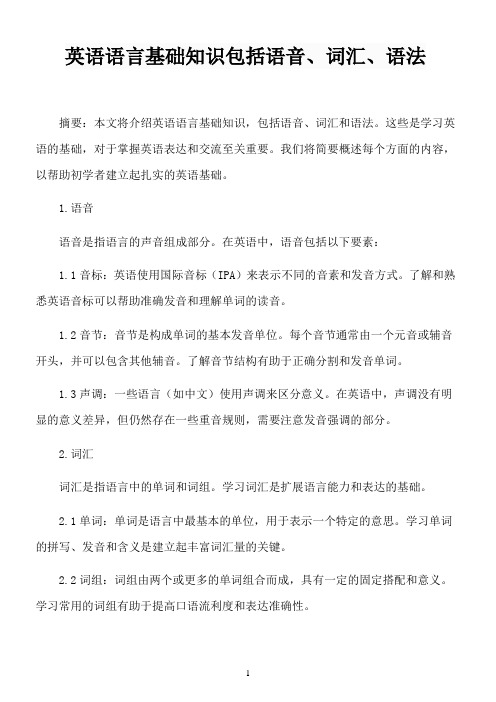
英语语言基础知识包括语音、词汇、语法摘要:本文将介绍英语语言基础知识,包括语音、词汇和语法。
这些是学习英语的基础,对于掌握英语表达和交流至关重要。
我们将简要概述每个方面的内容,以帮助初学者建立起扎实的英语基础。
1.语音语音是指语言的声音组成部分。
在英语中,语音包括以下要素:1.1音标:英语使用国际音标(IPA)来表示不同的音素和发音方式。
了解和熟悉英语音标可以帮助准确发音和理解单词的读音。
1.2音节:音节是构成单词的基本发音单位。
每个音节通常由一个元音或辅音开头,并可以包含其他辅音。
了解音节结构有助于正确分割和发音单词。
1.3声调:一些语言(如中文)使用声调来区分意义。
在英语中,声调没有明显的意义差异,但仍然存在一些重音规则,需要注意发音强调的部分。
2.词汇词汇是指语言中的单词和词组。
学习词汇是扩展语言能力和表达的基础。
2.1单词:单词是语言中最基本的单位,用于表示一个特定的意思。
学习单词的拼写、发音和含义是建立起丰富词汇量的关键。
2.2词组:词组由两个或更多的单词组合而成,具有一定的固定搭配和意义。
学习常用的词组有助于提高口语流利度和表达准确性。
2.3同义词和反义词:同义词是指具有相似意义的词语,而反义词则是具有相反意义的词语。
了解和使用同义词和反义词可以丰富表达方式。
3.语法语法是指语言的结构和规则。
学习语法有助于理解句子的构成和正确使用语言。
3.1句子结构:英语句子通常由主语、谓语和宾语构成。
了解不同类型的句子结构(陈述句、疑问句、祈使句等)以及标点符号的运用是重要的。
3.2时态和语态:时态表示动作发生的时间,语态表示动作的主体。
学习不同的时态和语态有助于准确表达事件的发生和参与者。
3.3句子成分:了解名词、动词、形容词、副词等句子成分的作用和用法,可以更好地理解和构建复杂句子。
结论掌握英语的语音、词汇和语法是学习和运用英语的基础。
熟悉语音规则、积累词汇量、学习语法结构和规则,对于提高听说读写的能力至关重要。
英语语言学大全
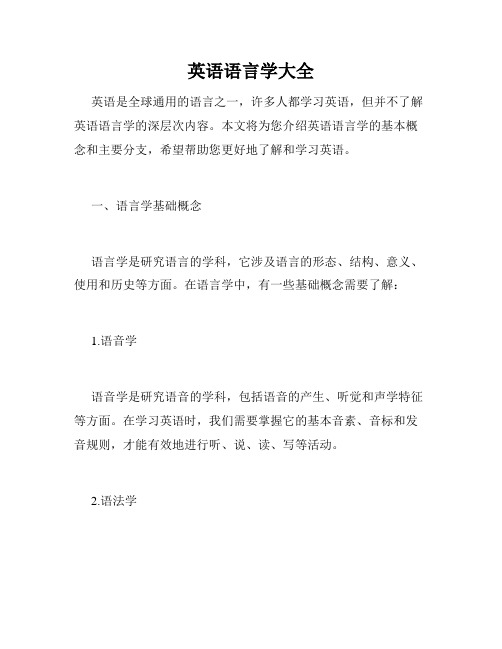
英语语言学大全英语是全球通用的语言之一,许多人都学习英语,但并不了解英语语言学的深层次内容。
本文将为您介绍英语语言学的基本概念和主要分支,希望帮助您更好地了解和学习英语。
一、语言学基础概念语言学是研究语言的学科,它涉及语言的形态、结构、意义、使用和历史等方面。
在语言学中,有一些基础概念需要了解:1.语音学语音学是研究语音的学科,包括语音的产生、听觉和声学特征等方面。
在学习英语时,我们需要掌握它的基本音素、音标和发音规则,才能有效地进行听、说、读、写等活动。
2.语法学语法学是研究语言结构和组织的学科,有时也称为句法学。
它研究语言的词类、句子结构、语法关系等方面。
通过学习英语的语法,我们可以正确使用语言,避免出现语法错误。
3.语义学语义学是研究语言意义的学科,它探究词汇、短语和句子意义的形成和变化。
在英语学习中,我们需要理解单词和短语的意义,以及句子的含义,以便正确理解和表达内容。
4.语用学语用学是研究语言使用的学科,包括口语和书面语言的使用场合、对话方式、说话人的语言目标和对听者的影响等方面。
在英语学习中,我们需要了解不同场合和对象的语言使用规范,以便与人交流时更加得心应手。
二、英语语言学的主要分支除了以上基础概念外,英语语言学还有一些重要的学术分支,能够帮助我们更深入地了解和掌握英语。
1.语音学英语语音学探究的是英语中的音素、音标和发音规则等方面,以及与其他语音系统的比较和差异。
2.语法学英语语法学研究的是英语的句法结构、语法关系和句子意义等方面,以及与其他语言的比较和翻译问题。
3.词汇学英语词汇学是研究英语词汇的学科,包括单词的来源、组成和意义等方面,以及与其他语言的比较和词汇翻译问题。
4.语用学英语语用学研究的是英语在语言使用中的实际应用,包括语言交际、言语行为、语境和语言目的等方面。
5.文本语言学英语文本语言学是研究英语文本的结构、组织和语言特点等方面的学科,包括语篇分析和修辞分析等内容。
英语语言学知识

英语语言学知识English:1. What is the study of English language called?The study of English language is called English linguistics or English language studies.2. What are the main branches of English language studies?The main branches of English language studies include phonetics, phonology, morphology, syntax, semantics, pragmatics, and sociolinguistics.3. What is phonetics?Phonetics is the study of the physical sounds of human speech, including the production and perception of speech sounds.4. What is phonology?Phonology is the study of the sound patterns of a language, including the way sounds are organized and used in the language.5. What is morphology?Morphology is the study of the structure and formationof words in a language, including the ways in which words are formed and the relationships between different forms ofa word.6. What is syntax?Syntax is the study of the structure and formation of sentences in a language, including the rules and principles that govern how words are combined to form grammatical sentences.7. What is semantics?Semantics is the study of the meaning of words, phrases, and sentences in a language, including how meaning is constructed and interpreted in communication.8. What is pragmatics?Pragmatics is the study of the use of language in context, including how language is used to convey meaning and achieve communicative goals in different social and cultural settings.9. What is sociolinguistics?Sociolinguistics is the study of the relationship between language and society, including how language varies and changes in different social and cultural contexts.10. What are the major theories of language acquisition?The major theories of language acquisition include behaviorist theories, nativist theories, interactionist theories, and cognitive theories.中文:1. 英语语言学的研究叫什么?英语语言学的研究叫做英语语言学或英语语言研究。
f45英语语言文学基础知识
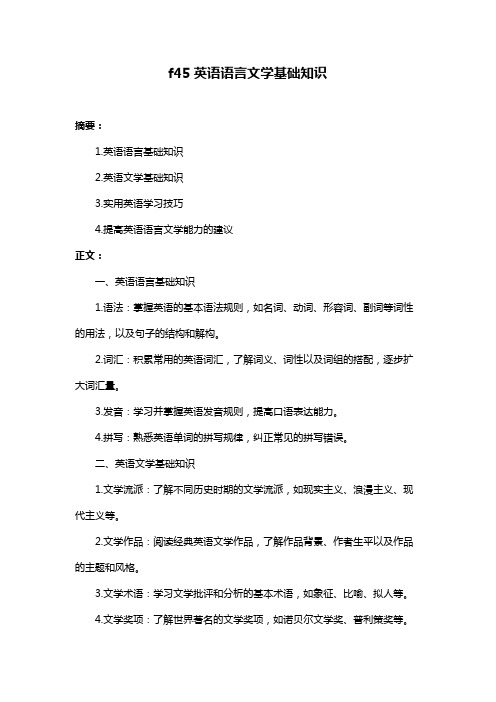
f45英语语言文学基础知识摘要:1.英语语言基础知识2.英语文学基础知识3.实用英语学习技巧4.提高英语语言文学能力的建议正文:一、英语语言基础知识1.语法:掌握英语的基本语法规则,如名词、动词、形容词、副词等词性的用法,以及句子的结构和解构。
2.词汇:积累常用的英语词汇,了解词义、词性以及词组的搭配,逐步扩大词汇量。
3.发音:学习并掌握英语发音规则,提高口语表达能力。
4.拼写:熟悉英语单词的拼写规律,纠正常见的拼写错误。
二、英语文学基础知识1.文学流派:了解不同历史时期的文学流派,如现实主义、浪漫主义、现代主义等。
2.文学作品:阅读经典英语文学作品,了解作品背景、作者生平以及作品的主题和风格。
3.文学术语:学习文学批评和分析的基本术语,如象征、比喻、拟人等。
4.文学奖项:了解世界著名的文学奖项,如诺贝尔文学奖、普利策奖等。
三、实用英语学习技巧1.制定学习计划:根据自己的实际情况,制定合理的学习计划,确保学习效果。
2.多媒体辅助学习:利用网络资源和手机应用,进行听、说、读、写的综合训练。
3.练习题库:做大量的练习题,巩固所学知识,提高应试能力。
4.学习小组:加入英语学习小组,与他人分享学习心得,共同进步。
四、提高英语语言文学能力的建议1.坚持每天学习:养成良好的学习习惯,保持学习的连续性和稳定性。
2.大量阅读:阅读英语文章、书籍,提高阅读速度和理解能力。
3.口语实践:积极参加英语角、语言交换等活动,提高口语实际应用能力。
4.学习与实践相结合:将所学知识运用到实际生活和工作场景中,实现学以致用。
通过以上四个方面的学习和实践,相信大家的英语语言文学能力会得到显著提高。
英语语言学基础知识
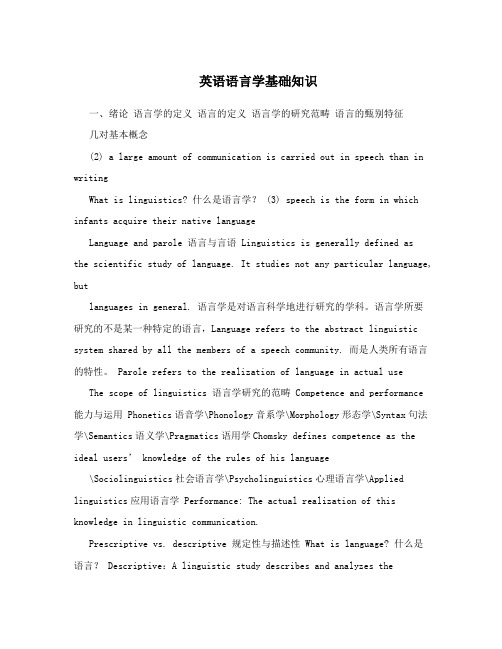
英语语言学基础知识一、绪论语言学的定义语言的定义语言学的研究范畴语言的甄别特征几对基本概念(2) a large amount of communication is carried out in speech than in writingWhat is linguistics? 什么是语言学? (3) speech is the form in which infants acquire their native languageLanguage and parole 语言与言语 Linguistics is generally defined asthe scientific study of language. It studies not any particular language, butlanguages in general. 语言学是对语言科学地进行研究的学科。
语言学所要研究的不是某一种特定的语言,Language refers to the abstract linguistic system shared by all the members of a speech community. 而是人类所有语言的特性。
Parole refers to the realization of language in actual use The scope of linguistics 语言学研究的范畴 Competence and performance 能力与运用 Phonetics语音学\Phonology音系学\Morphology形态学\Syntax句法学\Semantics语义学\Pragmatics语用学Chomsky defines competence as the ideal users’ knowledge of the rules of his language\Sociolinguistics社会语言学\Psycholinguistics心理语言学\Applied linguistics应用语言学 Performance: The actual realization of this knowledge in linguistic communication.Prescriptive vs. descriptive 规定性与描述性 What is language? 什么是语言? Descriptive:A linguistic study describes and analyzes thelanguage people actually use. Language is a system of arbitrary vocal symbols used for human communicationCharacteristics of language: 语言的特性 Prescriptive: it aims lay dow n rules for “correct” behavior.Modern linguistics is descriptive; its investigations are based on authentic and mainly spoken data. Language is a rule-governed system Traditional grammar is prescriptive; it is based on “high” written language. Language is basically vocalSynchronic vs. diachronic 共时性与历史性 Language is arbitrary (the fact different languages have different words for the same object is a good illustration the description of a language at some point in time is a synchronic study of the arbitrary nature of language. This conventional nature of language is well illustrated by a famous the description of a language as it changes through time is a diachronic study quotation from Shakespeare’s play “Romeo and Juliet”: “A rose by any other name wou ld smell as sweet.”)in modern linguistics, synchronic study seems to enjoy priority over diachronic study. Language is used for human communication Speech and writing 口头语与书面语 Design features of language 语言的甄别特征 Speech enjoys priority over writing in modern linguistics study for the following reasons: American linguist Charles Hackett specified 12 design features:(1) speech precedes writing in terms of evolution1) arbitrariness 武断性 4) displacement移位性 2) productivity 创造性5) cultural transmission 文化传递性3) duality 二重性二、音系学语言的声音媒介音系学和语音学什么是语音学语音、音位、音位变体发音器官音位对立、互补分部、最小对立音标……宽式和严式标音法几条音系规则英语语音的分类超切分特征构成了语言的声音媒介。
英语语言学-语言学知识点

定义:language is passed on from generation to generation through teaching and learning rather than instinct.
Cultural Transmission(文化传递性):
3. Design feature 定义特征
语言学知识点
CLICK HERE TO ADD A TITLE
单击此处添加文本具体内容
演讲人姓名
01
02
03
I 语言学导论
II 语言学主要分支学科
III 语言学的流派和理论
design feature of language (语言的定义特征) Language Families (世界语言分类) important distinctions in linguistics (语言学研究中几对重要的概念) scope of linguistics (语言学的研究范围)
Arbitrariness(任意性)
01
Duality(二层性)
02
Creativity/Productivity(创造性)
03
Displacement(移位性)
04
Cultural Transmission(文化传递性)
05
1)Arbitrariness(任意性): 定义:the forms of linguistic signs bear no natural relationship to their meaning. 举例: 书, book, livre 喜欢,like,aimer
Duality(二层性):
定义:the property of having two levels of structures, such that units of the primary level are composed of elements of the secondary level.
f45英语语言文学基础知识

f45英语语言文学基础知识英语语言文学是一门关于英语语言和文学的学科,它研究英语的起源、演变、用法和文学作品的创作、风格等方面。
本文将为您介绍一些F45级别的英语语言文学基础知识。
第一部分:英语语言基础知识1. 英语的起源与发展英语起源于古代日耳曼语,并受到了盎格鲁-撒克逊人、凯尔特人和诺曼人的影响。
随着英国的殖民扩张,英语逐渐成为全球通用语言之一。
2. 英语的语音和音标英语中的音标共有26个字母和一些特殊符号组成。
其中元音和辅音的发音方式不同,需要通过学习和练习来掌握。
3. 英语的语法和句法英语的语法包括词汇、词性、句子结构和语法规则等。
例如,英语中的主语和谓语之间需要一致,动词的时态和语态的变化等。
4. 英语的词汇与短语英语包含了大量的词汇和短语,需通过记忆和练习来扩充词汇量。
熟练掌握常用的表达方式和搭配使得交流更加流畅。
第二部分:英语文学基础知识1. 英语文学的历史分期英语文学可以分为古代英语文学、中世纪英语文学、文艺复兴时期英语文学、启蒙时期英语文学、浪漫主义时期英语文学、维多利亚时期英语文学和现代英语文学等阶段。
2. 英语文学中的经典作品英语文学中有许多经典的文学作品,如莎士比亚的戏剧作品《哈姆雷特》、狄更斯的小说《雾都孤儿》和奥斯卡·王尔德的剧本《温莎的风格》等。
熟悉并阅读这些作品可以培养对英语文学的理解和欣赏能力。
3. 英语文学的文体和风格英语文学中的文体和风格多种多样,如诗歌、小说、戏剧、散文、报告文学等。
每种文体都有其独特的表达方式和创作特点。
4. 英语文学的主题与思想英语文学作品涵盖了各种各样的主题与思想,例如爱情、友谊、人性、社会问题和战争等。
通过阅读这些作品可以拓展对英语文学作品的认知。
总结:本文简要介绍了F45级别的英语语言文学基础知识。
英语语言基础知识包括英语的起源与发展、语音和音标、语法和句法以及词汇与短语等方面。
而英语文学基础知识包括英语文学的历史分期、经典作品、文体和风格以及主题与思想等方面。
英语基础知识总结大全

英语基础知识总结大全一、英语的起源英语是一种属于日耳曼语族的语言,起源于古代日耳曼部落。
随着时间的推移,英语逐渐演变成一种全球通用的语言,被广泛使用于政治、商业、文化以及科技领域。
二、英语的语音英语语音主要包括元音(vowels)和辅音(consonants)两大类。
元音分为长元音和短元音,辅音则根据发音方式和位置分为不同的类别。
正确的语音是建立良好口语表达的基础。
三、英语的语法英语语法包括词法和句法两部分。
词法涉及词的构成和功能,句法则关注句子的结构、成分和语序。
了解英语的基本语法规则有助于提高表达的准确性和流畅性。
四、英语的词汇英语词汇是丰富多彩的,包括常用词汇、专业术语、俚语等。
积累词汇是提升英语表达能力的重要手段,可以通过阅读、听力、写作等方式进行词汇扩充。
五、英语的听力英语听力对于语言学习至关重要,可以提高听力理解能力和口语表达流畅度。
通过听取各种英语材料,如音频、视频、广播等,可以提高听力水平。
六、英语的阅读英语阅读是提高词汇量、语法理解和语感锻炼的有效途径。
阅读英语原版书籍、报纸、杂志等文本,可以拓展视野,提高阅读理解能力。
七、英语的写作英语写作是语言表达的重要形式之一,通过书面表达可以提高逻辑思维和语法应用能力。
写作涉及句子结构、段落组织、写作技巧等内容,通过练习可以不断提升写作水平。
八、英语的口语英语口语能力直接关系到语言交流的效果。
通过参加英语口语训练班、与外国人交流、参加口语比赛等方式可以提高口语表达能力,增加交流的流利度和信心。
九、英语的文化学习一门语言不仅仅是学习其语言知识,还包括学习其文化、习俗和背景。
了解英语国家的文化和社会环境,有助于更好地理解和运用语言。
十、总结英语作为一种全球通用的语言,具备重要的交流和应用价值。
通过对英语基础知识的全面了解和学习,可以提高英语能力,拓展视野,为未来的发展打下坚实基础。
以上是关于英语基础知识的总结,希望对您的学习和应用有所帮助。
英语课程中的语言学基础知识

英语课程中的语言学基础知识在英语学习过程中,了解语言学的基础知识是非常重要的。
本文将介绍一些英语课程中的语言学基础知识,帮助读者更好地理解和学习英语。
一、语言的定义和特征语言是人类最基本的交流工具,它具有以下几个特征:1. 可以传递信息:语言通过语音、文字等形式传递信息,使人们能够相互理解和沟通。
2. 组成规则性:语言具有一定的语法规则,包括词汇、句子结构等,通过这些规则组织语言的表达。
3. 具有音、义两个层面:语言既有音的层面,即语音学,也有词汇、句法等层面,即语义学。
4. 社会性:语言是社会群体的共同表征,不同社群有不同的语言系统。
二、语音学基础知识语音学研究的是语言的声音部分,包括音素、音节、音变等。
在英语学习中,掌握语音学的基础知识有助于正确发音和理解他人的语音信息。
1. 音素:音素是语言中的最小语音单位,可以区分词义。
英语中有约40个音素,包括元音和辅音。
2. 音节:音节是组成词的基本单位,它包括一个或多个音素。
英语中,音节由元音或元音组合的辅音开头,辅音结尾的形式组成。
3. 重音:重音在英语中具有很重要的作用,它通常落在词的某个音节上,加强了该音节的语音强度和音高。
三、语法学基础知识语法学是语言学中的重要分支,研究的是词汇、句法等语言结构的规则和规律。
掌握基本的语法知识对于理解和使用英语语法非常有帮助。
1. 词汇:词汇是语言中的基本单位,通过词汇可以组成不同的句子和表达。
英语中的词汇分为名词、动词、形容词等不同类别,并具有单复数、时态、语态等语法特征。
2. 句法:句法研究语言中句子的结构和成分之间的关系。
了解句法规则可以帮助我们正确组织句子和理解句子的意义。
3. 语法关系:在句子中,词语之间有很多不同的关系,比如主谓关系、动宾关系、定语从句等,了解这些语法关系对于正确理解句子结构和意义非常重要。
四、语义学基础知识语义学研究语言的意义和词语之间的关系。
在英语学习中,了解语义学基础知识可以帮助学习者更准确地理解和使用英语词汇。
英语语言学知识点整理
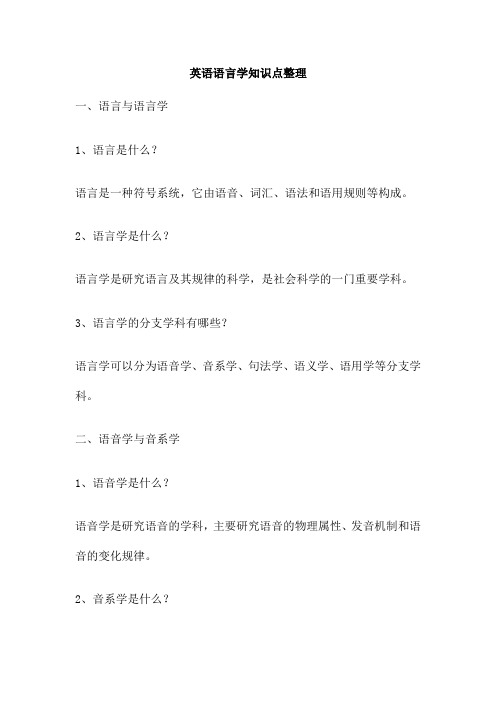
英语语言学知识点整理一、语言与语言学1、语言是什么?语言是一种符号系统,它由语音、词汇、语法和语用规则等构成。
2、语言学是什么?语言学是研究语言及其规律的科学,是社会科学的一门重要学科。
3、语言学的分支学科有哪些?语言学可以分为语音学、音系学、句法学、语义学、语用学等分支学科。
二、语音学与音系学1、语音学是什么?语音学是研究语音的学科,主要研究语音的物理属性、发音机制和语音的变化规律。
2、音系学是什么?音系学是研究语言的音系系统的学科,它的是语言的音位、音素、音节、语素等基本单位以及它们之间的组合关系和变化规律。
3、语音和音系的关系是什么?语音是音系的具体表现形式,而音系则是语音的基础和框架。
语音受到个人的发音和语境的影响,而音系则是一种抽象的概念,它是语言社团所共同遵守的规则。
三、句法学1、句法学是什么?句法学是研究句子的结构和规律的学科。
它主要的是词类、句子成分的构成和它们之间的组合关系。
2、句法学的核心概念有哪些?句法学的核心概念包括:词类、句子成分、句法关系、句型等。
3、常见的句法结构有哪些?常见的句法结构包括:简单句、复合句、并列句、复合并列句等。
四、语义学1、语义学是什么?语义学是研究语言意义的学科,主要研究词义、短语意义、句子意义和语篇意义等。
2、语义的分类有哪些?语义可以分为词汇意义、语法意义和语用意义。
词汇意义是指词汇的基本意义,语法意义是指词汇在句子中的组合关系和变化规律,语用意义是指词汇在特定语境中的特殊意义。
3、语义关系有哪些?语义关系包括:同义关系、反义关系、上下义关系等。
同义关系是指两个或多个词义相同或相似的词语之间的关系,反义关系是指两个或多个词义相反的词语之间的关系,上下义关系是指一个词所表达的概念是另一个词所表达的概念的一部分。
语言学知识点整理语言学是一门研究人类语言的学科,涉及语言的各个方面,包括语言的结构、使用、习得和进化等。
以下是一些常见的语言学知识点:1、语言与言语:语言是指一种符号系统,是人们用来表达思想、情感和意愿的工具。
英语语言学语言学知识点

英语语言学语言学知识点语言学是一门研究语言的学科。
它涵盖了多个领域,包括语音学、语法学、语义学、语用学和语言变化等。
下面将简要介绍一些语言学的重要知识点。
一、语音学(Phonetics)语音学是研究语音的学问。
它关注语音的产生、传播和感知等方面。
在语音学中,语音被分为音素(phoneme)和音位(allophone)。
音素是语言中最小的语音单位,可以在语言中起到区分意义的作用。
而音位是相同意义的不同实现方式,即同一音素的不同发音形式。
在语音学中,还有一些重要概念,如元音(vowel)和辅音(consonant)。
元音是语音学中最基本、最重要的音类,它们的发音不受任何阻塞或摩擦的干扰。
而辅音则需要通过口腔或喉头的阻塞或摩擦才能产生。
二、语音语调学(Phonology)语音语调学是研究语音和语调现象的学问。
它研究语音和语音的组织方式和相互关系。
在语音语调学中,音位和音位组成规则是核心概念之一、音位组成规则决定了在一个语言中哪些音位可以成为合法的音节。
此外,在语音语调学中还有音变(phonological variation)的概念。
音变指的是在其中一种语言中,一个特定音位的发音方式会随着不同的语音环境而发生变化的现象。
音变是语言变化的一种重要表现。
三、语法学(Grammar)语法学是研究语言的结构和规则的学问。
在语法学中,句子是一个重要的研究对象。
句子结构可以划分为短语(phrase)和句子成分(sentence constituents),如名词短语、动词短语和介词短语等。
语法学还涉及到句子的成分顺序和组成规则。
在语法学中,句法树(syntactic tree)是一种图形表示方式,用于描述句子的结构。
句法树由句子的各个成分和它们之间的关系构成。
四、语义学(Semantics)语义学是研究词汇和句子意义的学问。
它关注词语和句子的语义性质、意义的产生机制以及词义的转换等。
在语义学中,可以通过语义角色(semantic role)和逻辑关系(logical relation)来描述词语和句子之间的关系。
英语基础知识总结
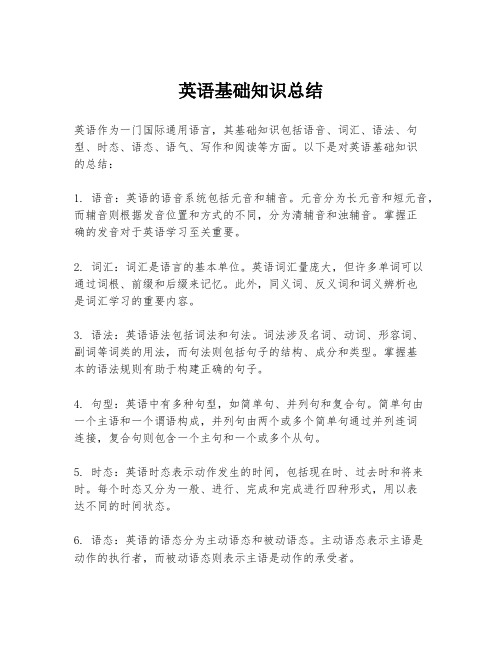
英语基础知识总结英语作为一门国际通用语言,其基础知识包括语音、词汇、语法、句型、时态、语态、语气、写作和阅读等方面。
以下是对英语基础知识的总结:1. 语音:英语的语音系统包括元音和辅音。
元音分为长元音和短元音,而辅音则根据发音位置和方式的不同,分为清辅音和浊辅音。
掌握正确的发音对于英语学习至关重要。
2. 词汇:词汇是语言的基本单位。
英语词汇量庞大,但许多单词可以通过词根、前缀和后缀来记忆。
此外,同义词、反义词和词义辨析也是词汇学习的重要内容。
3. 语法:英语语法包括词法和句法。
词法涉及名词、动词、形容词、副词等词类的用法,而句法则包括句子的结构、成分和类型。
掌握基本的语法规则有助于构建正确的句子。
4. 句型:英语中有多种句型,如简单句、并列句和复合句。
简单句由一个主语和一个谓语构成,并列句由两个或多个简单句通过并列连词连接,复合句则包含一个主句和一个或多个从句。
5. 时态:英语时态表示动作发生的时间,包括现在时、过去时和将来时。
每个时态又分为一般、进行、完成和完成进行四种形式,用以表达不同的时间状态。
6. 语态:英语的语态分为主动语态和被动语态。
主动语态表示主语是动作的执行者,而被动语态则表示主语是动作的承受者。
7. 语气:语气表示说话人对句子所表达内容的态度,包括陈述语气、疑问语气、祈使语气和虚拟语气。
不同的语气用于不同的语境和目的。
8. 写作:英语写作包括句子的构建、段落的组织和文章的结构。
良好的写作技巧不仅需要正确的语法和词汇,还需要清晰的逻辑和恰当的表达。
9. 阅读:英语阅读能力的提高需要广泛的阅读实践和词汇量的积累。
通过阅读不同类型的文本,可以提高理解力和分析力。
10. 听力和口语:听力和口语是英语交流的重要组成部分。
通过听英语材料和与他人用英语交流,可以提高听力理解能力和口语表达能力。
总之,英语基础知识的学习是一个系统的过程,需要不断地实践和积累。
通过掌握这些基础知识,可以为进一步的英语学习打下坚实的基础。
英语语言基础的知识点概述
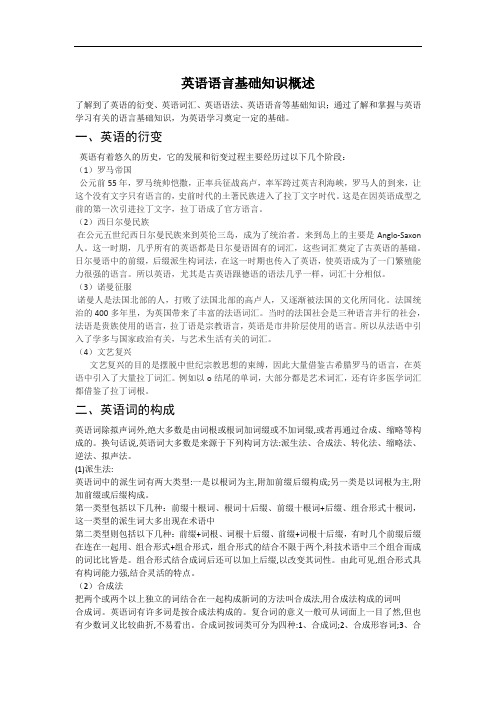
英语语言基础知识概述了解到了英语的衍变、英语词汇、英语语法、英语语音等基础知识;通过了解和掌握与英语学习有关的语言基础知识,为英语学习奠定一定的基础。
一、英语的衍变英语有着悠久的历史,它的发展和衍变过程主要经历过以下几个阶段:(1)罗马帝国公元前55年,罗马统帅恺撒,正率兵征战高卢,率军跨过英吉利海峡,罗马人的到来,让这个没有文字只有语言的,史前时代的土著民族进入了拉丁文字时代。
这是在因英语成型之前的第一次引进拉丁文字,拉丁语成了官方语言。
(2)西日尔曼民族在公元五世纪西日尔曼民族来到英伦三岛,成为了统治者。
来到岛上的主要是Anglo-Saxon 人。
这一时期,几乎所有的英语都是日尔曼语固有的词汇,这些词汇奠定了古英语的基础。
日尔曼语中的前缀,后缀派生构词法,在这一时期也传入了英语,使英语成为了一门繁殖能力很强的语言。
所以英语,尤其是古英语跟德语的语法几乎一样,词汇十分相似。
(3)诺曼征服诺曼人是法国北部的人,打败了法国北部的高卢人,又逐渐被法国的文化所同化。
法国统治的400多年里,为英国带来了丰富的法语词汇。
当时的法国社会是三种语言并行的社会,法语是贵族使用的语言,拉丁语是宗教语言,英语是市井阶层使用的语言。
所以从法语中引入了学多与国家政治有关,与艺术生活有关的词汇。
(4)文艺复兴文艺复兴的目的是摆脱中世纪宗教思想的束缚,因此大量借鉴古希腊罗马的语言,在英语中引入了大量拉丁词汇。
例如以o结尾的单词,大部分都是艺术词汇,还有许多医学词汇都借鉴了拉丁词根。
二、英语词的构成英语词除拟声词外,绝大多数是由词根或根词加词缀或不加词缀,或者再通过合成、缩略等构成的。
换句话说,英语词大多数是来源于下列构词方法:派生法、合成法、转化法、缩略法、逆法、拟声法。
(1)派生法:英语词中的派生词有两大类型:一是以根词为主,附加前缀后缀构成;另一类是以词根为主,附加前缀或后缀构成。
第一类型包括以下几种:前缀十根词、根词十后缀、前缀十根词+后缀、组合形式十根词,这一类型的派生词大多出现在术语中第二类型则包括以下几种:前缀+词根、词根十后缀、前缀+词根十后缀,有时几个前缀后缀在连在一起用、组合形式+组合形式,组合形式的结合不限于两个,科技术语中三个组合而成的词比比皆是。
- 1、下载文档前请自行甄别文档内容的完整性,平台不提供额外的编辑、内容补充、找答案等附加服务。
- 2、"仅部分预览"的文档,不可在线预览部分如存在完整性等问题,可反馈申请退款(可完整预览的文档不适用该条件!)。
- 3、如文档侵犯您的权益,请联系客服反馈,我们会尽快为您处理(人工客服工作时间:9:00-18:30)。
英语语言学基础知识一、绪论语言学的定义语言的定义语言学的研究范畴语言的甄别特征几对基本概念(2) a large amount of communication is carried out in speech than in writingWhat is linguistics? 什么是语言学? (3) speech is the form in which infants acquire their native languageLanguage and parole 语言与言语 Linguistics is generally defined asthe scientific study of language. It studies not any particular language, butlanguages in general. 语言学是对语言科学地进行研究的学科。
语言学所要研究的不是某一种特定的语言,Language refers to the abstract linguistic system shared by all the members of a speech community. 而是人类所有语言的特性。
Parole refers to the realization of language in actual use The scope of linguistics 语言学研究的范畴 Competence and performance 能力与运用 Phonetics语音学\Phonology音系学\Morphology形态学\Syntax句法学\Semantics语义学\Pragmatics语用学Chomsky defines competence as the ideal users’ knowledge of the rules of his language\Sociolinguistics社会语言学\Psycholinguistics心理语言学\Applied linguistics应用语言学 Performance: The actual realization of this knowledge in linguistic communication.Prescriptive vs. descriptive 规定性与描述性 What is language? 什么是语言? Descriptive:A linguistic study describes and analyzes thelanguage people actually use. Language is a system of arbitrary vocal symbols used for human communicationCharacteristics of language: 语言的特性 Prescriptive: it aims lay dow n rules for “correct” behavior.Modern linguistics is descriptive; its investigations are based on authentic and mainly spoken data. Language is a rule-governed system Traditional grammar is prescriptive; it is based on “high” written language. Language is basically vocalSynchronic vs. diachronic 共时性与历史性 Language is arbitrary (the fact different languages have different words for the same object is a good illustration the description of a language at some point in time is a synchronic study of the arbitrary nature of language. This conventional nature of language is well illustrated by a famous the description of a language as it changes through time is a diachronic study quotation from Shakespeare’s play “Romeo and Juliet”: “A rose by any other name wou ld smell as sweet.”)in modern linguistics, synchronic study seems to enjoy priority over diachronic study. Language is used for human communication Speech and writing 口头语与书面语 Design features of language 语言的甄别特征 Speech enjoys priority over writing in modern linguistics study for the following reasons: American linguist Charles Hackett specified 12 design features:(1) speech precedes writing in terms of evolution1) arbitrariness 武断性 4) displacement移位性 2) productivity 创造性5) cultural transmission 文化传递性3) duality 二重性二、音系学语言的声音媒介音系学和语音学什么是语音学语音、音位、音位变体发音器官音位对立、互补分部、最小对立音标……宽式和严式标音法几条音系规则英语语音的分类超切分特征构成了语言的声音媒介。
Phonetics语音学: Is defined as the study of the phonic medium of language; it is concerned with all the sounds Two major media of communication: Speech and writingThe limited range of sounds which are meaningful in human communication and are of interest to linguistic that occur in the world’s language. studies are the phonic medium of language. 用于人类语言交际的声音称为语音,这些数目有限的一组语音Three branches of phonetics : articulatory phonetics 发音语音学(most highly developed), auditory phonetics1听觉语音学and acoustic phonetics 声学语音学 01) Velum: The soft palate. 软腭 Organs of speech 发音器官 02) uvula: A small, conical, fleshy mass of tissue suspended from the center of the soft palate. 小舌,悬雍垂悬垂在软腭中央的小的圆锥状肉块 The articulatory apparatus of a human being are contained in three important areas or cavities:The pharyngeal cavity咽腔----the throat 03) larynx: n. 喉 The oral cavity口腔----the mouth 04) vocal cord: 声带 The nasal cavity 鼻腔---the nose 05) membrane: n. A thin, pliable layer of tissue covering surfaces or separating or connecting regions, structures, Vibration of the vocal cords (声带) results in a quality of speech sounds called “voicing” 浊音,which is a or organs of an animal or a plant. 膜薄而柔软的组织层,覆盖在表面或分割连接各种区域、结构或动植物feature of all vowels 元音 and some consonants 辅音。
器官单词补充:06) the soft palate: 软腭 10) the teeth: 牙齿 07) the hard palate:硬腭 11) the lips: 上下唇 08) the teeth ridge: 齿龈 12) blade of tongue: 舌面13) back of tongue: 舌根 09) alveolus: A tooth socket in the jawbone牙槽颚骨处的牙床 14) pharyngeal cavity: 咽腔16) velar: Articulated with the back of the tongue touching or near the soft palate, as (g) in good and (k) in cup.15) nasal cavity: 鼻腔软腭音的用舌头后部挂触或靠近软腭清楚地发音的,如在 good中的(g)以及在 cup中的(k)17) the tip of the tongue: 舌尖 19) the roof of the mouth: 上颚 18) the upper front teeth: 上齿 20) the lower lip: 下唇音标……宽式和严式标音法 :the openness of the mouth,口的张开程度:the shape of the lips园唇与否 International Phonetic Alphabet (IPA) The vowels (monophthongs and diphthongs) 元音(单元音&双元音) :length of the vowels元音的长度 The constants 辅音Broad transcription: Transcription with letter-symbols only. (in dictionaries and teaching textbooks)用一个符号来表示一个语音的标音方式叫做宽式标音法,这种音标法常见于词典和教科书。
